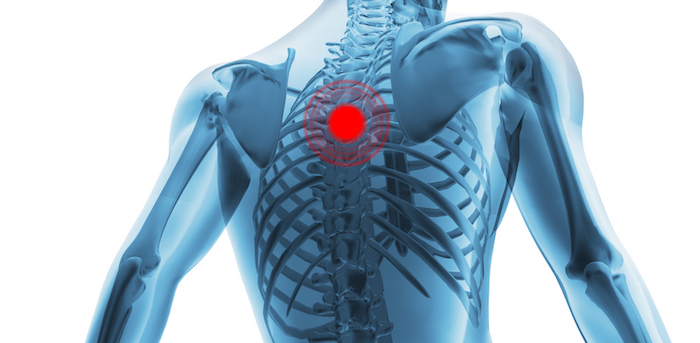
When upper back pain has lingered or not responded to rest and other self-care methods, a medical professional may be needed to develop a treatment plan that can reduce the pain.
Nonsurgical Medical Care for Upper Back Pain
Some of the more common medical treatments for upper back pain include:
- Physical therapy. A physiatrist, physical therapist, or other qualified medical professionals can design a physical therapy program to meet the patient’s specific needs. Most physical therapy programs for upper back pain focus on strengthening and stretching the upper back’s muscles, as well as neck muscles above and core muscles below. Physical therapy starts gradually and typically progresses over a period of a few weeks or months, at which point the patient can switch to a maintenance program at home.
- Prescription pain medications. For debilitating pain or severe flare-ups, short-term use of prescription medications may be advised. Common examples include prescription-strength nonsteroidal anti-inflammatory drugs (NSAIDs), opioids, which work by preventing pain signals from reaching the brain; and muscle relaxants, which typically work as a sedative for the neuromuscular system.
- Injections. Several spinal injection options are available to block spinal pain. For example, an epidural steroid injection typically delivers a steroid medication in or near the pain source to reduce pain. Injections tend to provide varying amounts of short-term relief and are not considered a good long-term solution.
- Cognitive-behavioral therapy. A therapist can teach new and better ways to think about challenges. For example, a patient might be able to increase his or her ability to follow a doctor’s treatment plan by becoming more aware of negative thoughts and instead focusing on the positives.
Commonly, more than one treatment is needed to help manage upper back pain. For example, medications might be needed when the pain first starts, but over time the medications might be phased out in favor of physical therapy or other treatments to manage ongoing chronic pain.
Alternative Treatments
Alternative treatments, commonly referred to as complementary and alternative medicine (CAM), are gaining in popularity. While alternative treatments tend to have less scientific backing than traditional medical treatments, that is not to say they are ineffective. Many people have reported experiencing at least some pain relief from these treatments. Some examples of alternative treatments include:
- Manual manipulation. A chiropractor, physiatrist, or other qualified medical professional makes spinal adjustments by using hand thrusts and other maneuvers. Manual manipulation (also known as chiropractic manipulation) helps loosen stiff or misaligned joints and may reduce pain.
- Acupuncture. Depending on the specific pain symptoms, an acupuncturist places thin needles in strategic locations of the body to theoretically alter energy flows, ease tension, and reduce pain.
- Electrotherapy. Various electrotherapy treatments aim to alleviate pain by sending small electrical pulses to the painful area. The most common type of electrotherapy is a transcutaneous electrical nerve stimulator (TENS). A TENS unit typically uses small adhesive pads to place electrodes at multiple locations on or near the painful region, such as the upper back. Using an adjustable knob, the TENS unit sends electrical current to the electrodes that may cause a soothing, tingling sensation and reduce the perception of pain.
- Mindful meditation. Sometimes referred to as mindfulness-based stress reduction, this flexible approach typically involves learning meditation and breathing techniques, as well as practicing yoga. Research has found value in mindfulness-based stress reduction, including one study that found it to be as effective as cognitive behavioral therapy for improving a patient’s ability to deal with chronic back pain.1
Several other alternative treatments also exist.
Surgery for Upper Back Pain
It is rare for upper back pain to be treated with surgery. However, surgery may be indicated if one or more of the following conditions are met:
- The health of the spinal cord or nerve roots are at risk.
- Severe spinal deformity has developed or is likely to develop.
- Debilitating pain cannot be managed with non-surgical methods.
If surgery is chosen for thoracic spine pain, it is typically one of the following two types:
- Vertebral augmentation. This minimally invasive procedure involves injecting artificial bone cement into a vertebra’s compression fracture to stabilize it, stop the damaged bone’s painful movements, and prevent further vertebral collapse. Two common types of vertebral augmentation are vertebroplasty and the newer balloon kyphoplasty.
- Spinal decompression. This type of surgery can relieve pressure on a nerve root and/or the spinal cord in order to prevent worsening damage that could lead to dysfunction or paralysis. For example, a spinal decompression surgery could remove a structure that has started to press against a nerve or the spinal cord, such as a herniated disc or bony overgrowth (osteophyte), or other structures. In some cases, a spinal decompression procedure is combined with a fusion to stabilize that section of the spine.
Compared to the cervical spine and lumbar spine, some additional challenges exist when operating on the thoracic spine, including the difficulty of working around the rib cage and the close proximity of several vital organs.
Precision Pain Care and Rehabilitation has two convenient locations in Richmond Hill – Queens and New Hyde Park – Long Island. Call the Richmond Hill office at (718) 215-1888, or (516) 419-4480 for Long Island office, to arrange an appointment with our Interventional Pain Management Specialist, Dr. Jeffrey Chacko.













